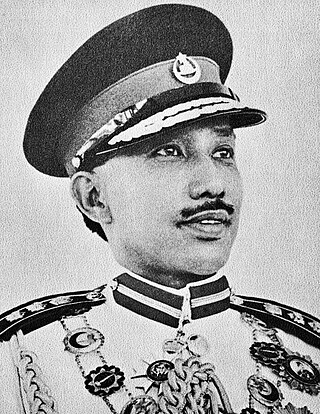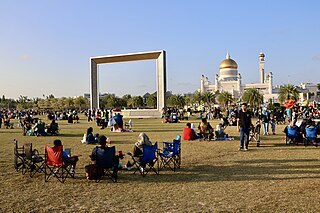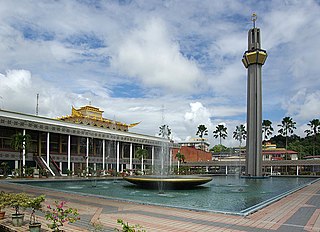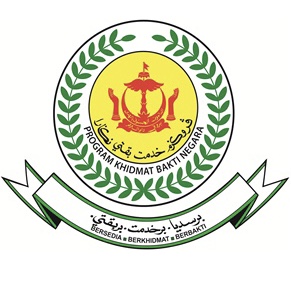
Omar Ali Saifuddien Sa'adul Khairi Waddien was the 28th Sultan of Brunei, reigning from 1950 until his abdication in 1967 to his oldest son, Hassanal Bolkiah.

Brunei–Muara District or simply known as Brunei–Muara, is the smallest as well as the most populated district in Brunei. It has an area of 571 square kilometres (220 sq mi) and the population of 318,530 as of 2021. The district is also home to its administrative centre is Bandar Seri Begawan, as well as the Brunei International Airport and Muara Port, the country's only international airport and deep-water port respectively. The Brunei River flows within this district and is home to Kampong Ayer. As the administrative center of Brunei is located in the district, it remains the most developed in the country with the most up-to-date infrastructure, despite not being the center of Brunei's main economic activity.
Melayu Islam Beraja was officially proclaimed as the national philosophy of Brunei on the day of its independence on 1 January 1984 by Sultan Hassanal Bolkiah.

The Lapau, also known as the Royal Ceremonial Hall, is a ceremonial hall in Bandar Seri Begawan, Brunei. It is where the royal ceremonies, state investiture and some state events are traditionally held. It was the place where the present Sultan of Brunei, Sultan Hassanal Bolkiah, was crowned in 1968.
The regalia of Malaysia includes all the items which are deemed sacred and symbolic of the supremacy and authority of the Yang di-Pertuan Agong or the Supreme King of Malaysia and his consort, the Raja Permaisuri Agong. The installation of the Supreme King is a very special ceremony. Only on this particular day are the masses able to see his regalia. Several of these are Malaysian National Treasures since 2009.

Majeedah Nuurul Bolkiah is princess in the Brunei royal family. She is the fourth child of Sultan Hassanal Bolkiah and Queen Saleha. She presently serves as the Department of the Environment, Parks and Recreation's Senior Environment Officer and Chief of the Planning and Management Division. This organization is part of the Ministry of Development.
Sulaiman ibni Sharif Ali, also known as Senior King and Adipati Agung, was the fifth Sultan of Brunei, according to Silsilah Raja-Raja Berunai. He succeeded his father in 1432 and ruled until his abdication in 1485, to allow his son Bolkiah to become Sultan.
Muhammad Hasan ibni Saiful Rijal, posthumously known as Marhum di Tanjung, was the sultan of Brunei from 1582 to 1598. During his reign, the Bruneian Empire had full control of the island of Borneo and Northern Philippines, including Sulu.

Pusat Bandar is the city centre of Bandar Seri Begawan, the capital of Brunei. It is home to a number of national landmarks, important government offices, and commercial and financial establishments.

The Malay Technology Museum is a museum in Kota Batu of Bandar Seri Begawan, Brunei. The museum's main objective is to present early Brunei's technical practices, which provide insight into the way of life of the country's inhabitants, who lived in both the water town and on dry ground.

Hassanal Bolkiah Muiz'zaddin Wad'daulah is Sultan of Brunei since 1967, and prime minister of Brunei since its independence from the United Kingdom in 1984. He is one of the few remaining absolute monarchs in the world.

The National Service Programme,, is the voluntary national service programme in Brunei Darussalam for youth citizens aged 16 to 21. The programme lasts three months, and engagement is voluntary. The programme started in December 2011, as a pilot study, and was made permanent in 2014. It is managed by the Ministry of Culture, Youth and Sports.

The Royal Mausoleum in Batu Satu, Bandar Seri Begawan, is a significant historical and cultural landmark in Brunei. Located along the Brunei River, it lies beyond Kampong Ayer and on the route from Bandar Seri Begawan to the Istana Nurul Iman. This site serves as the final resting place for several Bruneian sultans and members of the royal family, with Sultan Omar Ali Saifuddin I, who died in 1795, being the first monarch interred here.

The Golden Jubilee of Hassanal Bolkiah was a celebration held throughout Brunei Darussalam in October 2017 to celebrate the Sultan Hassanal Bolkiah's Golden Jubilee; his 50th year on the Bruneian throne.

The Istana Darussalam is the former residence of Omar Ali Saifuddien III and birthplace of Sultan of Brunei, Hassanal Bolkiah. The palace is located at Jalan Darussalam, Kampong Sumbiling Lama, Brunei–Muara District, Brunei. The building has become a tourist attraction and currently under the protection of the Antiquities and Treasure Trove Act of the Museums Department.

The Old Lapau or formerly known as Lapau, is a historic building in Bandar Seri Begawan, Brunei. It was the former Lapau prior to the existence of the current Lapau building. It was also where the Constitution of Brunei was promulgated in 1959. It now houses a museum pertaining to the Constitution.

Mohammad Jamil Al-Sufri bin Umar, pen name Wijaya, was a Bruneian aristocrat, historian and teacher who served as a member of the Royal Council, member of the Royal Succession Council, member of the Islamic Religious Council, and member of the Privy Council. He has also been referred to as the National Historian. He wrote works on the country's history, ancestry, customs and traditions, royal titles, Malay Islamic Monarchy (MIB), education, writings on Brunei heroes, and other topics.

Mohammad Abbas Al-Sufri bin Haji Ibrahim was an aristocrat, civil servant and courtier from Brunei who previously served as the acting personal secretary to Sultan Omar Ali Saifuddien III. He had a career in the government service of Brunei, in which he held a number of important positions such as being a member of the Privy Council of Brunei from 1972 to 2014.
The Wazir are a group of royal dignitaries within the Sultanate of Brunei whose position ranks the second-highest official in the country behind the Sultan. The Wazir had formerly held the position of the Sultan's highest official in the administration of the then-reigning government throughout Brunei's history, particularly during the times prior to and after the British protectorate. The core of Brunei's nobility consisted of this class of governmental offices, and it consists of a Perdana Wazir, and Wazir Empat under him. Notably, they are sometimes referred to as and acted as Senior Ministers.

















